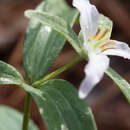mk
имиња во трошки


Trillium texanum, the Texas trillium or Texas wakerobin, is a species of flowering plant in the family Melanthiaceae. It is found in east Texas, extreme southwestern Arkansas, and extreme northwestern Louisiana. Due to its limited range, it is designated as a vulnerable species.
Trillium texanum is a perennial herbaceous plant that flowers from March to early mid-April, with white flower petals.[5]
Trillium texanum was first described by Samuel Botsford Buckley in 1861.[3] Its type specimen was collected in Panola County, Texas,[6] but that specimen is now lost.[7] The specific epithet texanum refers to the U.S. state of Texas, its primary location.
As of April 2023, the name Trillium texanum Buckley is widely recognized,[1][2][4][8] but a few authorities regard it as a variety of Trillium pusillum, either T. pusillum var. texanum or T. pusillum var. pusillum.[9][10] The taxon is a member of the Catesbaei group (Trillium subgen. Delostylis), a group of pedicellate-flowered trilliums that includes Trillium catesbaei.
Trillium texanum is found primarily in east Texas,[11] hence the common name Texas trillium. It also occurs in extreme southwestern Arkansas and extreme northwestern Louisiana.[1] It typically grows in forested wetland habitat.[5]
As of April 2023, the global conservation status of Trillium texanum is listed as vulnerable by both NatureServe and IUCN.[1][2] It is critically imperiled in both Arkansas and Louisiana.[12] It is under review by the U.S. Fish & Wildlife Service.[13]
Trillium texanum, the Texas trillium or Texas wakerobin, is a species of flowering plant in the family Melanthiaceae. It is found in east Texas, extreme southwestern Arkansas, and extreme northwestern Louisiana. Due to its limited range, it is designated as a vulnerable species.